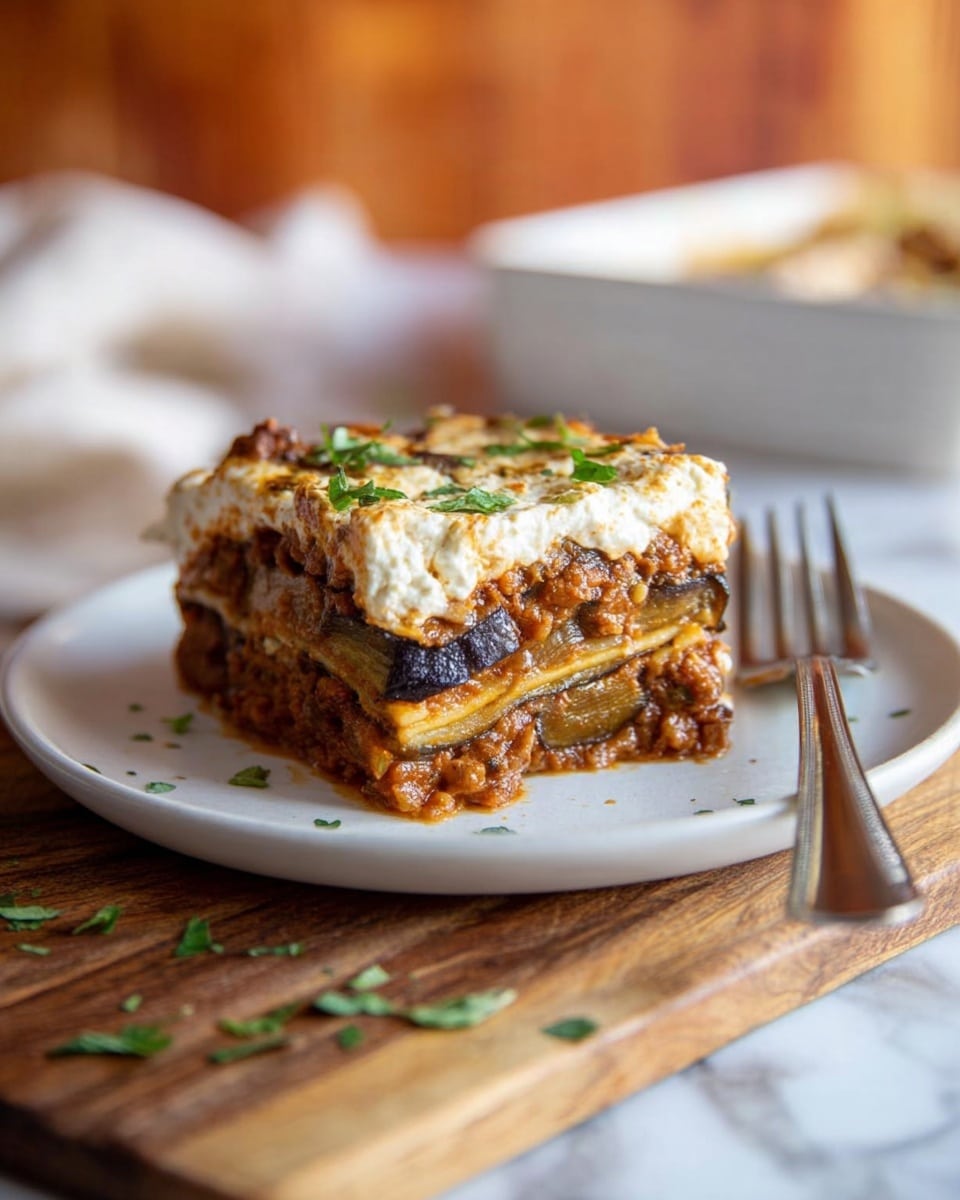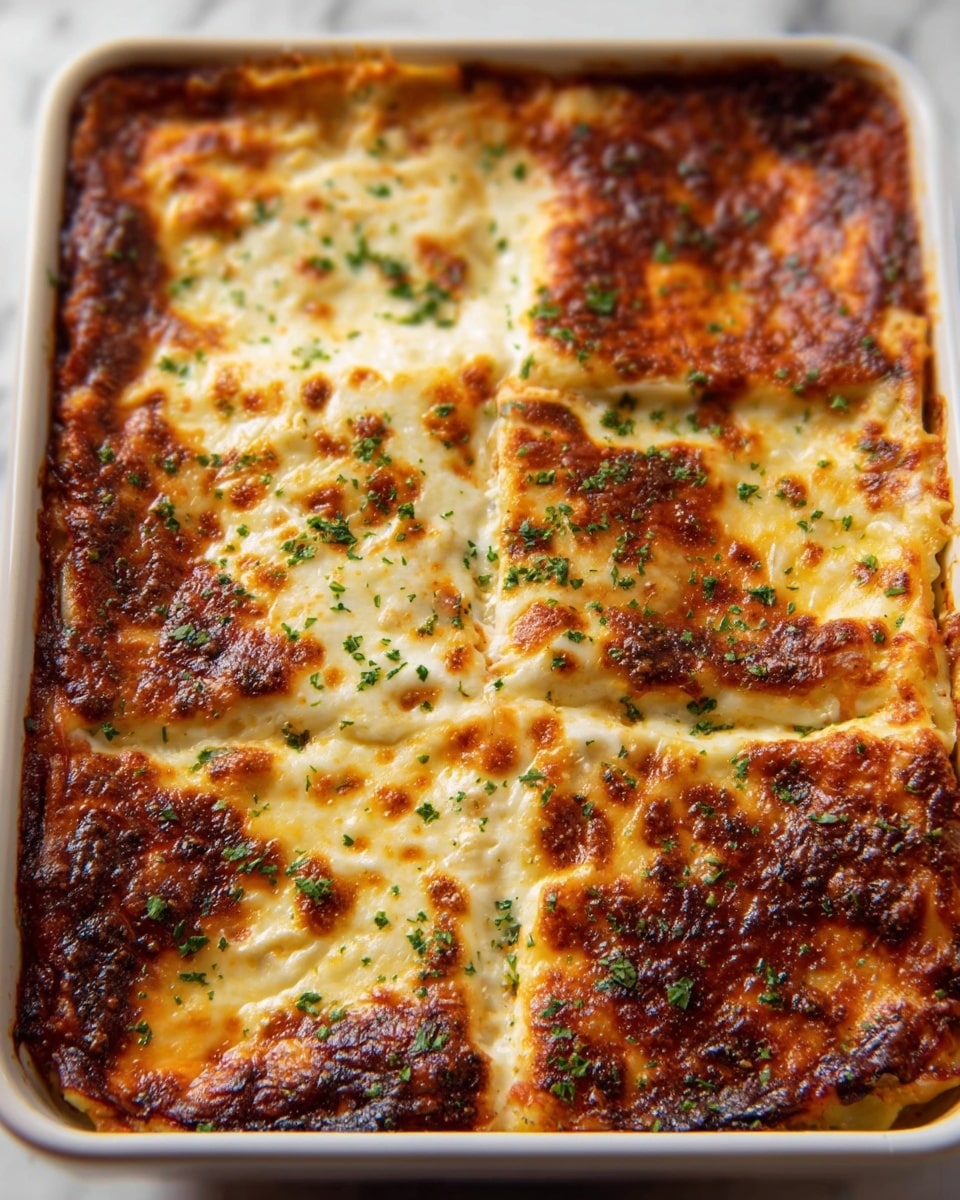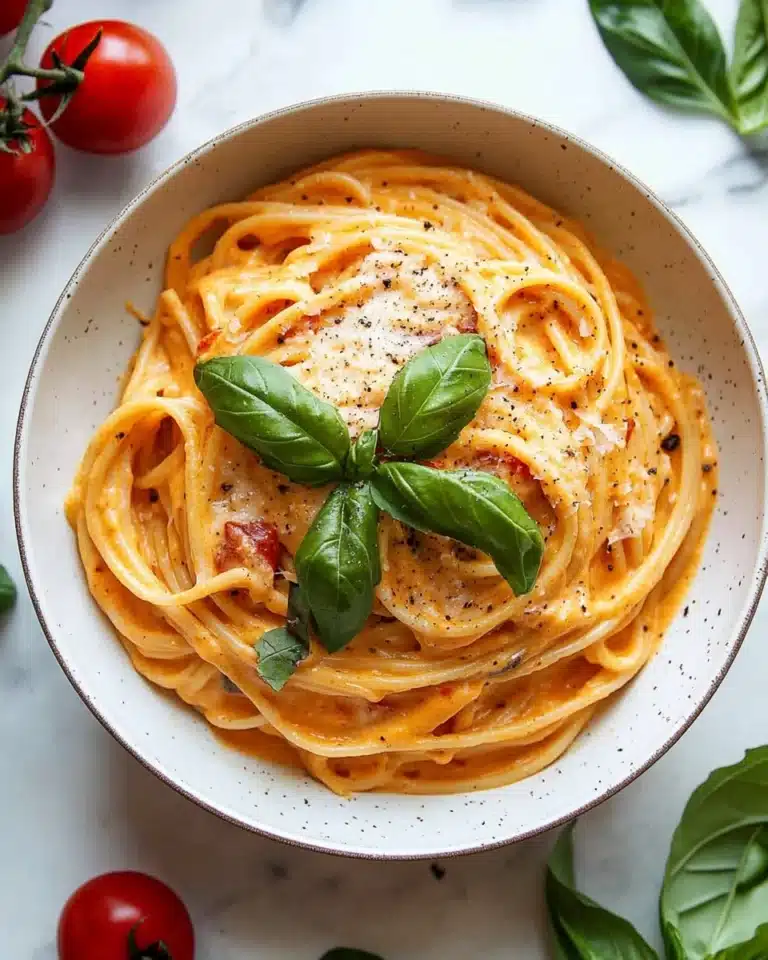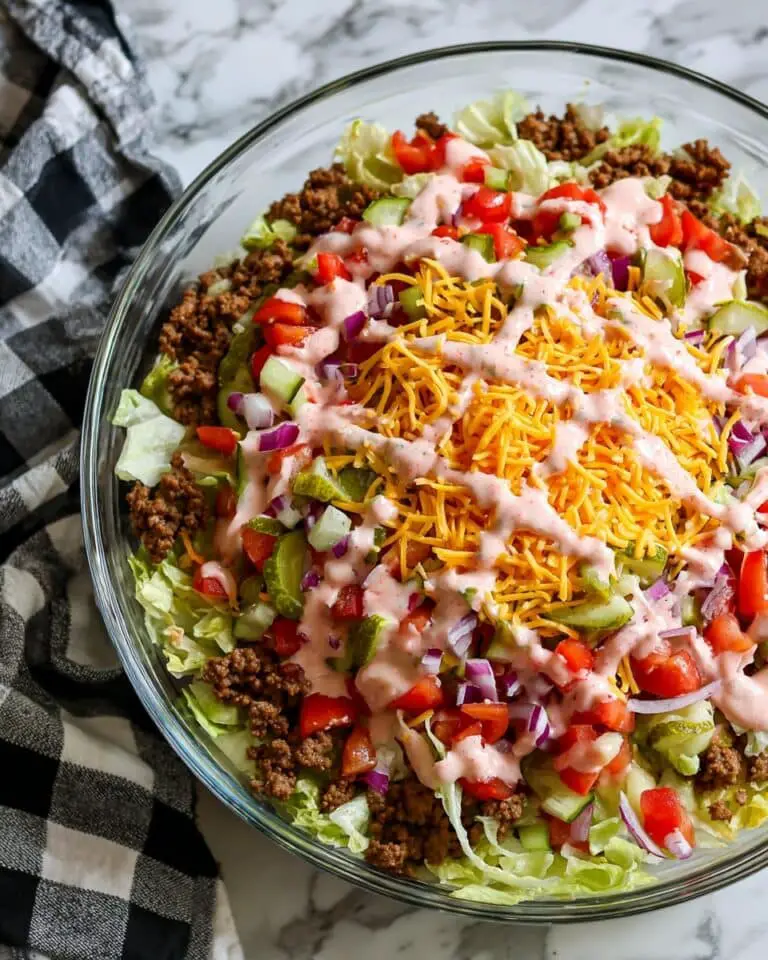Oh, I absolutely love sharing this Outrageously Greek Moussaka Recipe with you because it’s just one of those dishes that feels like a warm hug on a plate. When I first tried making authentic moussaka at home, I was amazed at how the layers of tender eggplant, zucchini, and potatoes combined with a luscious beef sauce and creamy béchamel created something truly special. It’s perfect for those cozy dinners when you want to impress your family or friends without having to order takeaway.
You’ll find that this Outrageously Greek Moussaka Recipe is not only rich in flavor but surprisingly approachable to make, especially once you get the hang of layering and frying the veggies just right. Plus, it’s a great dish to prep ahead — the flavors actually get better the next day, which is a total win if you’re looking to save time. Trust me, once you taste this, you’ll want to make it again and again!
Why You’ll Love This Recipe
- Authentic Flavor: Every bite bursts with the traditional spices, fresh herbs, and perfectly layered veggies that make Greek moussaka unforgettable.
- Make-Ahead Friendly: You can prep most of it in advance which makes dinner a breeze on busy nights or for entertaining.
- Customizable Veggies: Whether you prefer frying or baking your veggies, this recipe adapts beautifully to your kitchen setup and preferences.
- Creamy Béchamel Sauce: The velvety, cheesy topping makes this dish irresistibly rich and satisfying.
Ingredients You’ll Need
The magic of this Outrageously Greek Moussaka Recipe really comes down to fresh, quality ingredients working in harmony. I always recommend fresh herbs and whole milk for the béchamel to get that smoothest, creamiest sauce.
- Olive Oil: Adds a subtle, fruity depth; great for frying the veggies.
- White Onion: Finely diced to build the rich beef layer’s aroma.
- Garlic: Fresh cloves really brighten up the beef sauce.
- Ground/Minced Beef: Lean is best to keep the sauce hearty but not greasy.
- Tomato Paste (Tomato Puree): Gives that umami-packed tomato richness in the sauce.
- Dry Red Wine: Brings an acidity and complexity; you can swap for beef stock if you prefer.
- Tomato Passata: Smooth tomato base keeps the sauce luscious.
- Beef Stock: Enhances the meaty flavor in the beef layer.
- Fresh Parsley & Thyme: Bright, herbal notes that lift the entire dish.
- Bay Leaves: Infuse a subtle earthy warmth during simmering.
- Seasonings (Salt, Sugar, Cinnamon, Black Pepper): Key to balancing flavors beautifully.
- Unsalted Butter: Necessary for the béchamel’s roux base.
- Plain Flour: Thickens the béchamel perfectly.
- Milk: Room temp milk helps avoid lumps in your béchamel.
- Nutmeg & White Pepper: Give the béchamel a gentle warm spice without overpowering.
- Pecorino Romano Cheese: Traditional sharpness in the sauce and to sprinkle between layers.
- Egg Yolks: Enriched into the béchamel for extra creaminess.
- Baking Potatoes, Zucchini, Eggplants: The triumphant triad of layered veggies that define moussaka.
- Salt & Pepper: Essential for seasoning all layers properly.
Variations
I love how this Outrageously Greek Moussaka Recipe adapts to what you have on hand and your taste buds. I often customize it by swapping out frying for baking the veggies, especially when I want to keep things lighter or save time.
- Baked Veggies Variation: Baking the eggplant, zucchini, and potatoes instead of frying makes the layers less oily and lighter; I still get that great texture and the flavors meld wonderfully.
- Vegetarian Version: I’ve turned this into a meatless gem by swapping beef for lentils and mushrooms, which soak up all those spices beautifully while keeping it hearty.
- Cheese Choices: If you can’t find Pecorino Romano or Kefalotiri, aged Parmesan works great and keeps the flavor punchy.
- Herbs & Spices: Some days, I add a pinch of allspice or a touch of smoked paprika for a different twist that my family really enjoys.
How to Make Outrageously Greek Moussaka Recipe
Step 1: Build That Flavorful Beef Layer
Start by heating olive oil in a large pan over medium heat. Gently soften the diced onion until golden—this step is crucial because it lays the sweet, caramelized foundation of your sauce. Then add the garlic and let it cook just until fragrant, about a minute—don’t let it brown or it can turn bitter. Toss in your ground beef and break it up as it browns evenly; this ensures every bite has that meaty goodness. Stir in your tomato paste and fry it for a couple of minutes to deepen the flavor. Next, deglaze the pan with red wine, scraping the bottom so none of those tasty browned bits get left behind. Pour in passata and beef stock, then add fresh herbs, bay leaves, spices, salt, sugar, and pepper. Let this simmer gently for about 30 minutes, stirring occasionally until thick and rich with flavor. Trust me, this step is worth the time—it’s the heart of your moussaka.
Step 2: Prep and Cook the Veggie Layers
Now, prepping your vegetables is where a little patience pays off big time. Lay out layers of paper towels on your counter and salt your eggplant slices on both sides—this helps draw out bitterness and excess moisture. Stack them with paper towels between layers of zucchini and potatoes, pressing gently so they soak up the moisture. For cooking, heat enough oil in a pan to cover the veggies at around 150°C (300°F). Fry the potatoes first until golden and fork-tender, then the zucchini until lightly browned, and finally the eggplants, which will soak up the oil but deliver that melt-in-your-mouth texture. Drain everything well on paper towels to avoid soggy layers. If you’re in a hurry or prefer less oil, baking the veggies is a fantastic alternative I often use—simply coat in olive oil, salt, and pepper, and roast at 200°C (400°F), timing each veggie based on how quickly it cooks.
Step 3: Craft the Silky Béchamel Sauce
Ah, the béchamel—this creamy, cheesy topping makes the moussaka truly Outrageously Greek. Melt your butter over medium heat and whisk in the flour to make a roux—cook this gently until it’s golden but not browned. Gradually pour in warm milk, whisking continuously to avoid lumps (this is where you’ll want patience). Keep stirring until your sauce thickens enough to coat the back of a spoon; if it looks too thin, simmer a few more minutes. Then, remove from heat and mix in grated pecorino romano cheese until smooth. The final step is to quickly whisk in egg yolks—do this off the heat to prevent curdling—to give the sauce a luxurious richness that melts beautifully in the oven.
Step 4: Layer and Bake Your Moussaka Masterpiece
Time to assemble! Start with a layer of potatoes, slightly overlapping, then sprinkle with parsley, pecorino, salt, and pepper. Repeat this seasoning for the zucchini layer next, then half of the eggplant, pressing gently to close any gaps. Spread the thick, flavorful beef mixture evenly over the veggies, then finish with the remaining eggplant. Top it all off with a generous layer of béchamel sauce and a final sprinkle of pecorino. Bake uncovered at 180°C (350°F) for about 35–45 minutes until the top is beautifully golden and slightly browned. Here’s the trick I learned: let it rest at least 15 minutes after baking so it sets up nicely and slices without falling apart. Trust me, it’s worth the wait!
Pro Tips for Making Outrageously Greek Moussaka Recipe
- Don’t Skip Salting the Eggplant: This step removes bitterness and prevents sogginess, making your layers beautifully tender but firm.
- Use Room Temperature Milk for Béchamel: It helps avoid lumps, so pour slowly and whisk rigorously.
- Let Moussaka Rest Before Serving: Cutting too soon results in a messy dish; letting it sit helps flavors meld and the layers hold together.
- Adjust Oil Temperature While Frying: Keep the oil at medium heat to avoid greasy or burnt veg—slow and steady wins here.
How to Serve Outrageously Greek Moussaka Recipe

Garnishes
I love to finish this dish with freshly chopped parsley and a sprinkle more of Pecorino Romano right before serving—the pop of green looks beautiful against the golden béchamel, and that extra cheese adds a slight salty kick that just elevates every bite.
Side Dishes
A crisp Greek salad with fresh cucumber, tomatoes, olives, and feta is my go-to side—it cuts through the richness perfectly. Sometimes I’ll serve it alongside warm pita bread or a light lemony orzo salad to complement that Mediterranean vibe.
Creative Ways to Present
For special occasions, I sometimes make individual ramekin-sized moussakas — great for portion control and an elegant presentation. Alternatively, layering it beautifully in a clear glass baking dish gives a stunning vista of all those colorful veggie and meat layers, making it almost too pretty to cut into (almost!).
Make Ahead and Storage
Storing Leftovers
Once cooled, I cover leftovers tightly with foil or plastic wrap and keep them in the fridge—this moussaka stays delicious for up to 4 days. The flavors actually deepen overnight, which is a lovely bonus.
Freezing
I’ve frozen both the cooked whole dish and the beef layer separately with great results. For the full moussaka, freeze before baking, wrap tightly, and thaw overnight in the fridge before baking fresh. It reheats beautifully without losing texture or taste.
Reheating
To reheat, cover with foil and bake at 180°C (350°F) for about 30 minutes until piping hot in the middle. Avoid microwaving if possible, as the béchamel can sometimes separate and veggies may become soggy.
FAQs
-
Can I make this Outrageously Greek Moussaka Recipe vegetarian?
Absolutely! You can substitute the beef layer with a mix of lentils and sautéed mushrooms flavored with the same herbs and spices for a hearty vegetarian version that’s just as satisfying.
-
What’s the best way to prevent the vegetables from getting too oily?
Salting the eggplant and pressing out moisture helps a lot. Also, frying at moderate oil temperatures and draining the veggies well on paper towels after cooking keeps excess oil in check. Alternatively, baking the veggies cuts down on oil altogether.
-
Can I prepare the entire moussaka the day before serving?
Yes! You can assemble it the day before, keep it covered in the fridge, then bring to room temperature before baking. This actually helps the flavors meld beautifully.
-
Why does the béchamel sometimes get lumpy and how do I fix it?
Using room temperature milk and whisking continuously while gradually adding the milk prevents lumps. If lumps do form, you can strain the sauce or vigorously whisk it over low heat to smooth it out.
-
Can I use ground lamb instead of beef?
Definitely! Ground lamb adds a richer, more authentic flavor. Just remember lamb can be fattier, so you might want to drain some of the fat during cooking for a less greasy result.
Final Thoughts
This Outrageously Greek Moussaka Recipe holds a special place in my kitchen because it always brings everyone together around the table, ready to savor something comforting yet impressive. I remember the first time I served it to my family — the way the layers melded, the aromas filling the house, and the smiles around the table told me this was a keeper. You’re not just making a meal here; you’re crafting a tradition that’ll have everyone asking for seconds (and the recipe!). Give it a go — I promise it’s as rewarding as it is delicious.
Print
Outrageously Greek Moussaka Recipe
- Prep Time: 40 minutes
- Cook Time: 1 hour 10 minutes
- Total Time: 1 hour 50 minutes
- Yield: 8 servings
- Category: Main Course
- Method: Baking
- Cuisine: Greek
Description
This deliciously authentic Greek Moussaka features layers of tender fried vegetables, rich spiced ground beef, and a creamy, cheesy béchamel sauce baked to golden perfection. A classic Mediterranean comfort food that combines hearty flavors with a satisfying texture, perfect for family dinners or special occasions.
Ingredients
Beef Layer
- 1 tbsp Olive Oil
- 1 large White Onion, finely diced
- 2 cloves of Garlic, finely diced
- 1.6lb / 750g Ground/Minced Beef (preferably fairly lean)
- 2 heaped tbsp Tomato Paste (Tomato Puree in UK)
- 1/2 cup / 120ml Dry Red Wine (can substitute more beef stock)
- 1 cup / 240ml Tomato Passata (pureed/strained tomatoes)
- 1 cup / 240ml Beef Stock
- 1/4 cup finely diced Fresh Parsley, plus extra to serve
- 1 tbsp finely diced Fresh Thyme Leaves
- 2 small or 1 large Bay Leaf
- 3/4 tsp Salt, or to taste
- 1/2 tsp Sugar
- 1/2 tsp Cinnamon
- 1/4 tsp Black Pepper, or to taste
Béchamel Sauce
- 4oz / 120g Unsalted Butter
- 4oz / 120g Plain Flour
- 4 cups / 1 litre Milk, at room temperature
- 1/2 tsp Salt, or to taste
- 1/2 small Nutmeg, grated (or 1/4 tsp ground nutmeg)
- 1/4 tsp White Pepper
- 1 cup / 80g freshly grated Pecorino Romano, plus extra to serve (Kefalotiri or Parmesan can substitute)
- 2 Egg Yolks
Vegetable Layers
- 2 cups / 480ml Vegetable or Olive Oil, or enough to cover vegetables for frying
- 1.6lb / 750g (approx 2 large) Baking Potatoes, peeled and sliced about 1/4 inch thick
- 1lb / 500g (approx 2 medium) Zucchini/Courgettes, sliced into approx 1/3 inch strips (lengthwise)
- 2lb / 1kg (approx 4 small) Eggplants/Aubergine, sliced about 1/3 inch thick (lengthwise or rounds)
- Few pinches of fresh Parsley and Pecorino Romano cheese for sprinkling between layers
- Salt and Pepper, to taste
Instructions
- Prepare the Beef Layer: Heat 1 tablespoon of olive oil in a large pan or pot over medium heat. Add the finely diced onion and cook until soft and golden. Stir in the garlic and cook for another minute. Add the ground beef and brown it thoroughly, breaking it up as it cooks. Mix in the tomato paste and fry for a couple of minutes before pouring in the red wine to deglaze the pan. Then add the tomato passata and beef stock. Stir in the fresh parsley, thyme, cinnamon, salt, sugar, black pepper, and bay leaf. Simmer gently for about 30 minutes, stirring occasionally until the sauce thickens.
- Prepare the Vegetables Layer: Place eggplant slices on sheets of paper towel, salting both sides lightly. Layer additional paper towels and add zucchini slices, then potatoes, finishing with paper towels on top. Press gently to absorb excess moisture. Heat enough oil in a large frying pan to cover the vegetables (aim for 150ºC/300ºF for potatoes). Fry potato slices until lightly golden and tender, drain on paper towels. Increase oil temperature to 170ºC/340ºF and fry zucchini until soft and browned. Fry eggplant slices last until golden and tender. Drain everything on paper towels thoroughly to remove excess oil.
- Make the Béchamel Sauce: In a pot over medium heat, melt butter and whisk in flour to form a roux. Gradually add room temperature milk while whisking continuously to avoid lumps. Cook until thick enough to coat the back of a spoon. Season with salt, white pepper, and freshly grated nutmeg. Remove from heat, stir in grated pecorino cheese until smooth, then quickly whisk in the egg yolks to enrich the sauce.
- Combine Béchamel with Beef: Take about half a cup of the béchamel sauce and stir it into the beef mixture to bind the layers nicely.
- Assemble the Moussaka: In a baking dish, layer the potatoes evenly, sprinkle with parsley, pecorino, salt, and pepper. Add zucchini slices with seasoning, then half the eggplant with salt and pepper. Pack the layers tightly to close gaps. Spread the beef mixture over the vegetables, then top with the remaining eggplant slices. Pour the remaining béchamel sauce over the top, smoothing it out.
- Bake and Serve: Sprinkle extra pecorino cheese over the top and bake in a preheated oven at 180ºC/350ºF for 35-45 minutes or until the topping is golden and lightly charred. Allow the moussaka to rest for at least 15 minutes before serving to help it set and retain its shape. Serve warm and enjoy this classic Greek dish.
Notes
- You can bake the vegetables instead of frying by coating them in olive oil, salt, and pepper, then baking at 200ºC/400ºF. Potatoes take about 30 minutes; eggplant 20 minutes; zucchini 10-15 minutes or until tender and lightly golden.
- Beef layer can be made ahead of time; store in the fridge overnight or freeze up to a month. Reheat gently before assembling.
- The entire moussaka can be assembled ahead and refrigerated overnight before baking, or frozen. Bring to room temperature before baking.
- To reheat leftovers, bake covered with foil at moderate heat until piping hot throughout.
- Olive oil adds a distinctive flavorful zing when frying at lower temperatures, while vegetable oil provides a neutral flavor. Use according to preference and oil quantity needed.
- Calorie estimate assumes 5% fat beef and about 1/4 cup olive oil absorbed by vegetables, divided into 8 servings.
Nutrition
- Serving Size: 1 slice (approximately 1/8 of recipe)
- Calories: 450 kcal
- Sugar: 6 g
- Sodium: 450 mg
- Fat: 28 g
- Saturated Fat: 12 g
- Unsaturated Fat: 13 g
- Trans Fat: 0 g
- Carbohydrates: 30 g
- Fiber: 5 g
- Protein: 25 g
- Cholesterol: 110 mg









